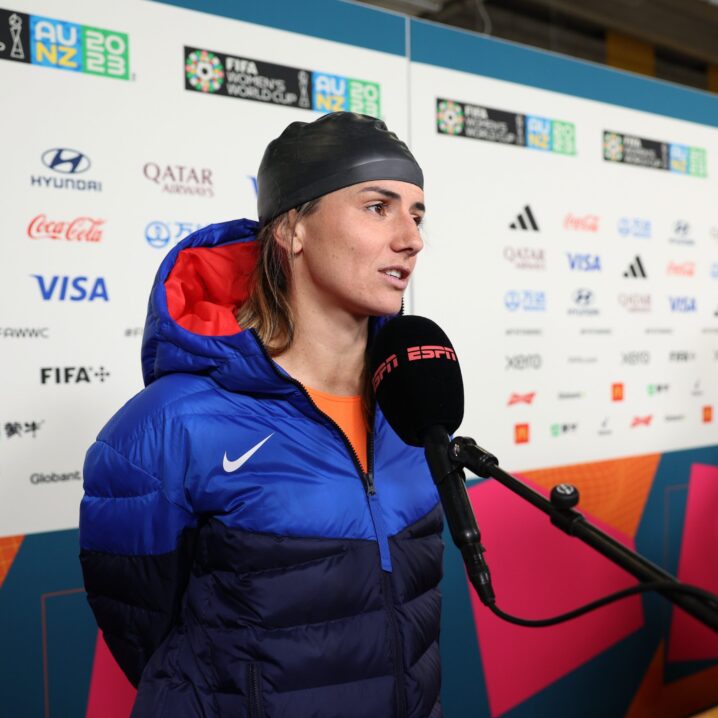
- POPSUGAR Australia
- Fitness
- Why a Swim Cap Is Sometimes Used to Handle Head Injuries in Soccer
Why a Swim Cap Is Sometimes Used to Handle Head Injuries in Soccer

Near the end of last night’s match between the US and the Netherlands at the 2023 FIFA Women’s World Cup, American player Rose Lavelle collided with Dutch player Daniëlle van de Donk. The incident left van de Donk with a bleeding cut on the side of her head, but she soon returned to the field of play sporting an unusual look: a black swim cap over her head. Naturally, there were plenty of questions about this unexpected choice, including how it actually helps with the injury.
Fans seemed both amused by the bizarre look and concerned about injuries while watching the events unfold. They took to social media, asking, for example, “hey for real what’s the swimming cap thing? some sort of concussion protocol, but… why?” and “From someone who missed the game at 2am I have a question. Why was Van de Donk wearing a swimming cap?” on Twitter.
According to van de Donk herself, the cap was put in place to help staunch the bleeding from the injury so that she could get back into the game. “It just opened up and it’s bleeding too much so I couldn’t continue the game without it,” she said after the match, as reported by USA Today.
She joked about the awkwardness of the cap situation with ESPN, too. “On my hand, [the bleeding] wasn’t too bad. I thought, ‘It will stop soon.’ Then the medical team was there. And then I heard, ‘Swim cap, swim cap!’ I said, ‘No, I really don’t want that!”
While unusual, it’s not the first time a soccer player has had a head injury “treated” with a swim cap placed over it. In 2022, Nicolás Otamendi finished a Champions League match wearing a cap after a collision. In 2020, Dario Benedetto also donned a swim cap after bleeding from a head collision during a French league game.
While many people on social media guessed that the swim cap had something to do with concussion protocol, Chris Nowinski, PhD, neuroscientist and CEO of the Concussion Legacy Foundation (CLF), says it was likely put on as a precaution because she was bleeding.
“I assume the swim cap was placed only because she had blood in her hair,” he tells POPSUGAR. “In prior World Cups, players have returned with bandages wrapped around their head when bleeding, which is an ugly visual. The World Cup tournament takes the risk of transmission of disease through blood very seriously, perhaps more seriously than concussions.” The swim cap offers better protection for a head injury that’s bleeding.
Reuben Chen, MD, board-certified sports medicine physician, pain management expert, and chief medical advisor at Sunrider International, agrees, noting that “a swim cap can be used to hold a bandage in place over a fresh wound without having to use tape all around a player’s head during a game,” he says. The swim cap can also help put pressure on the wound to slow the bleeding, and it may be able to lessen headache symptoms, as well, “by placing some compression on the scalp muscle, which can be a cause of tension headaches,” he says.
Though the swim cap was likely used for a superficial injury, Dr. Nowinski voiced concern over potential concussions for one or both players involved in the collision. “As an advocate for proper concussion protocols, it was difficult to watch both players return after a head-to-head collision with minimal evaluation,” he says. “Current rules only allow for a three-minute, on-field evaluation for concussion, at which point a player must either sub out of the game permanently or head to the sideline and check back into the match.” That’s a short window in a high-pressure situation, which could lead to concussion symptoms being missed. And this was a particularly heated match, considering the US and Netherlands battled it out in the 2019 World Cup final, where the US emerged the victor.
FIFA recently introduced “injury spotters” during last year’s men’s tournament who rewatch video in slow motion to alert team doctors to possible concussions, among other things. But Dr. Nowinski wishes even more would be done to protect players from the injuries, which occur at a higher rate in women athletes and can have devastating long-term effects such as memory and concentration problems, mood swings, personality changes, headaches, fatigue, and more, according to the American Association of Neurological Surgeons.
Here’s hoping both van de Donk and Lavelle have a speedy recovery and are able to play safely in the rest of the World Cup matches.
Related: Here’s What a Doctor Says About All Those (Painful-Looking) Headers at the World Cup

